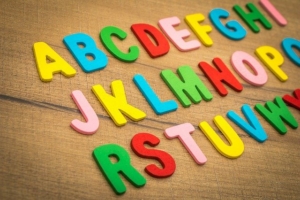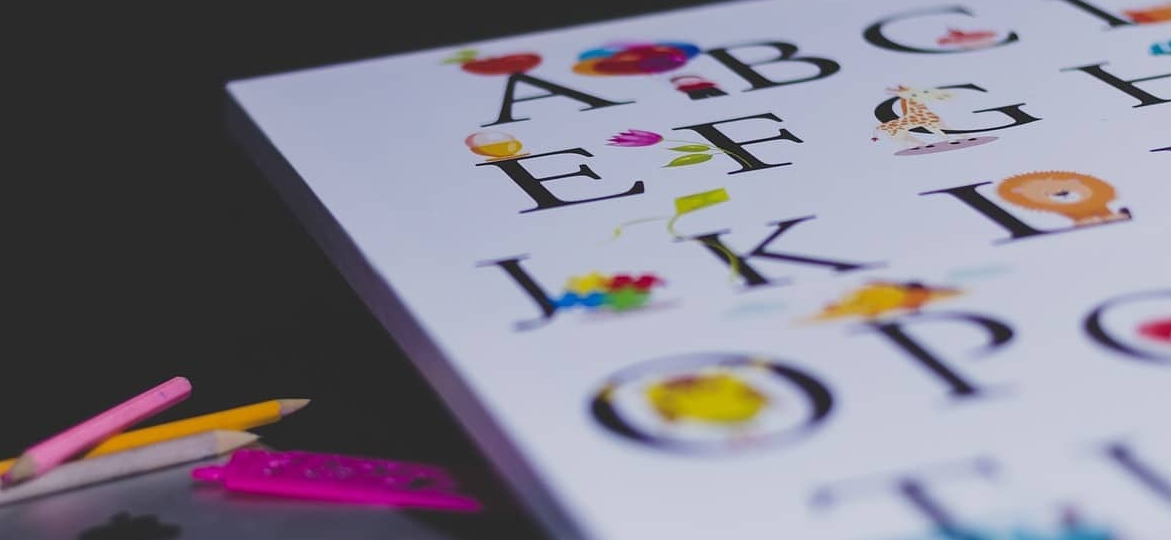The Spanish alphabet is one of those subjects that you must master first when learning this language. It is quite simple to remember, and it is very important to master it in order to have good spelling. The Spanish alphabet, often called “Abecedario”, is made up of twenty-seven letters. As in English, the Spanish alphabet contains 5 vowels: “a, e, i, o, u”. Next, we present an image that shows all the letters of the Spanish alphabet along with a recording with their pronunciation.
In this article you will learn:
- The importance of knowing the Spanish alphabet and its pronunciation;
- The Spanish phonetic alphabet;
- How to pronounce the Spanish alphabet;
- Special pronunciations in Spanish;
- Tips for memorizing and remembering the Spanish alphabet.
- How to learn Spanish and improve at your own pace with the General Español course by GlobalExam.
Let’s get started!
Why is it important to know the alphabet in Spanish and its pronunciation?
The knowledge of the alphabet, made up of vowels and consonants, is important for learning to read and write. Without the alphabet it would be impossible to elaborate a speech, or to communicate effectively by expressing our ideas. The relationship between the phonetics and the spelling of each letter allows us to know the language and expand the vocabulary.
The articulation of letter sounds stimulates various areas of the brain involved in language development. Logical thinking and mental representation or abstract thinking, is also consolidated with learning the alphabet. For this reason, one of the first lessons that boys and girls learn in school is the alphabet.
As for the pronunciation of the alphabet, unfortunately there is no magic recipe. The key is to practice and practice. It is important to listen to conversations, watch movies, play music, podcasts, and pay attention to the pronunciation and intonation of the letters. It is also important to practice saying the letters out loud and then put them in words and do the same with them.
If we want to speak Spanish well, we must avoid being ashamed to have a conversation in this language. Do not focus only on the grammar but try to improve your Spanish pronunciation every day. Learn to listen and lose your fear of speaking!

What is the Spanish alphabet?
Here are all the letters of the Spanish alphabet along with an example of a word beginning with that letter. Later we will see how to pronounce each letter.
| LETTER | EXAMPLE |
|---|---|
| A | Alberto |
| B | Barcelona |
| C | Casa |
| CH | Chocolate |
| D | Dinamarca |
| E | Eduardo |
| F | Francia |
| G | Girasol |
| H | Historia |
| I | Invierno |
| J | Jorge |
| K | Kilómetro |
| L | Laura |
| Ll | Llave |
| M | Murcia |
| N | Navarra |
| Ñ | Niño |
| O | Oslo |
| P | París |
| Q | Queso |
| R | Rosa |
| S | Segovia |
| T | Tenerife |
| U | Ucrania |
| V | Vaca |
| W | Washington |
| X | Xavier |
| Y | Yegua |
| Z | Zamora |
What is the Spanish phonetic alphabet and so the pronunciation of each letter?
In the table you will find the pronunciation of Spanish vowels and cosonants. These pronunciations are spelled in a way that will allow English speakers to pronounce these Spanish letter names as correctly as possible.
| LETTER | PHONETIC TRANSCRIPTION | ENGLISH PRONUNCIATION | EXAMPLE IN SPANISH | TRANSLATION OF EXAMPLE |
|---|---|---|---|---|
| A | a | AAH | Agua | Water |
| B | b | BAY – it has a dry sound and softer than English B | Bebé | Baby |
| C | k | SAY – Sound produced by air getting out of your mouth between the teeth and tongue. | Casa | House |
| D | d | DAY – Tongue in the same position as for C but sound is produced by the throat | Dos | Two |
| E | e | EY – Same sound as with the A in English. | Elefante | Elephant |
| F | f | EH-fay – Same sound as English F but opening mouth at the end. | Fotografía | Photography |
| G | ɣ | HAY- Like the English G in great. | Gato | Cat |
| H | No sound | AH-chay - The H is always silent at the beginning of a word | Helado | Ice-cream |
| I | i | EE – Same sound as an English double E. | Imán | Magnet |
| J | X | HOH-tah - The J sounds like the H in English | Juego | Game |
| K | k | KAH – Same sound as the Spanish C for Casa. | Koala | Koala |
| L | l | EH-lay - Tongue doesn’t touch the front teeth. Lighter than in ball. | León | Lion |
| M | m | EH-may – Like in English but separating your lips at the end. | Mano | Hand |
| N | n | EH-nay – Same as in M. | Naranja | Orange |
| Ñ | ñ | EH-nyay – Only exists in Spanish. | Niño | Boy |
| O | o | OOH – Long O. | Oso | Bear |
| P | p | PAY – Similar sound to English P. | Pingüino | Penguin |
| Q | k | COO – Same sound as Spanish C followed by “ue” or “ui”. The U is silent. | Queso | Cheese |
| R | r | EH-rray – The R has two sounds in Spanish: it’s strong at the beginning of a word, but soft anywhere else. | Ratón Loro | Mouse Parrot |
| S | s | EH-say – Like in English, but ending the same way as Spanish F and M. | Serpiente | Snake |
| T | t | TAY – After T mouth opens. | Tomate | Tomato |
| U | w | OOH – Sounds like double O. | Uno | One |
| V | β | DOH-blay – Sounds like soft B. | Uvas | Grapes |
| W | w | OOH-bay – Pronounced like letters V and B. | Sandwich | Sandwich |
| X | ks | EH-kees -The X has different sounds. In this example, it sounds just like the H in English. | México | Mexico |
| Y | I | YAY – Sounds like the Y in Yes. | Ayer | Yesterday |
| Z | z | SAY-tah | Zapato | Shoe |
Special pronunciations in Spanish
Here you can find some spacial pronunciation of letters in Spanish (single consonant, consonant + consonant, consonant + vowel).
| LETTER | PRONUNCIATION | EXAMPLE |
|---|---|---|
| LL | The Y in English like Yes. | Llama, Pollo. |
| Ñ | Like the “nio” sound in English like in Onion | España, Niño. |
| CH | Like the CH in Cheese. | Chocolate, Mucho. |
| QU | Same sound as Spanish C for Casa. The “U” is silent. | Queso, Quiebra. |
| B and V | In Spanish, B and V sound exactly alike but used for different words. They are pronounced somewhat like a soft version the English "b" after a pause and after the m sound | Vaca, Baca. Vello, Bello |
| CE, CI | It sounds like a K (hard) next to the vowels A, O and U. It sounds like an S (soft) when next to the letter E and I. | Capital, Cena, Cine. |
| CC | They do not separate from the pronunciation. The first C takes the sound of the second and it would have to be said with the force of a Spanish “K”. | Acción, lección. |
| GE, GI, J | These three letters sound close to the English H. J’s sound is always hard in Spanish and the G is hard when next to the latter there is an E or I. | Gerona, Gimnasio, Jamón. |
Tips for memorizing and remembering the Spanish alphabet
The first step in learning a language is to memorize the letters. Here are a few tips and tricks to remember the Spanish alphabet.
Learn the pronunciation of all the letters
Before you start reading in Spanish with the correct pronunciation you should know that each letter is pronounced in a different way, and these, although sometimes they are like the English alphabet, can be quite different and can sometimes confuse us. To learn how to pronounce each letter of the Spanish alphabet, it is always useful to visit a website where all the letters of the Spanish alphabet pronounce one by one and clearly.
Associate sounds with words and pictures
One of the most effective techniques is to associate the most conflicting letters with certain words that contain the sound. For example, the letter “J” in Spanish is pronounced the same as the word “Jota”, which is a type of dance.
Give a lot of importance to the conflicting letters
In general, there are always some letters in the Spanish alphabet that can get stuck and are more difficult to learn. If that is the case, we recommend that you practice them in a special name. Write down words that contain these letters and try to memorize them in your own way.
Repeat and practice endlessly
Like many things in life, the Spanish alphabet is only memorized by practicing and repeating constantly. Therefore, we recommend that you do not wait to memorize it by divine inspiration. Get started from the beginning. The sooner you do it, the sooner you can focus on other Spanish language things! In addition to repeating the alphabet, also try to repeat Spanish accents and rules of accentuation.
Find activities to memorize
To practice, we recommend activities such as:
- Looking at objects around you and spell the word
- Grab a dictionary, open any page, and spell the first word that you see.
- Group the letters of a word in pairs or groups
Once you are completely familiar with the pronunciation of each letter, we recommend that you start spelling things by grouping the letters in pairs or trios. For example: P-A (pause) P-E-L. Native speakers instinctively do this, so you will gradually sound more and more natural when it comes to spelling.
Improve Spanish with Global General
At GlobalExam we propose the Global General, an original 100% online, flexible, and intuitive learning method that adapts to your pace of life and your availabilities. You can learn wherever and whenever you want, with check sheets available always and detailed corrections for each question, which will allow you to expand your vocabulary and develop your communication skills in Spanish. The Global General is intended above all for people with a beginner or intermediate level who want to learn Spanish without stress and without the inconveniences of classical education, either at school or university.
Among all the articles that you have at your disposal in this category, you can start by reviewing how to learn Spanish in a simple and fast way with the methods and tips that we offer you. In addition, you will be able to know the peculiarities of pronunciation in Spanish with the rules that you will also find here. Finally, if you like novel and entertaining methods, we offer you tips on how to learn Spanish with videos and, also with soap operas. As you can see, we try to make your learning fun, but also satisfying to get you to communicate perfectly in Spanish.



